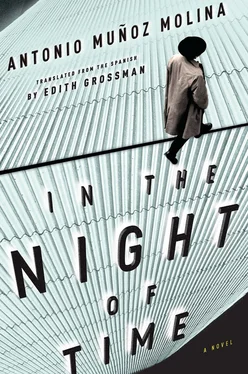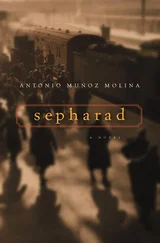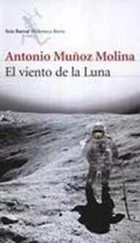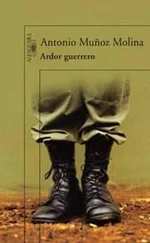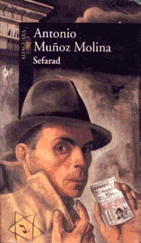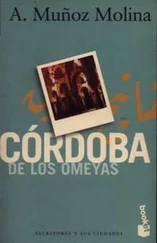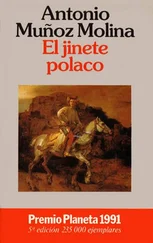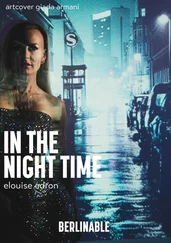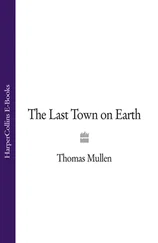The train moves forward along the river that pulls in the opposite direction, toward the sea, great barges loaded with minerals or mountains of scrap metal or garbage, and light sailboats suspended over the water, tossing like paper boats, white sails agitated by the wind in undulations similar to those on the surface where, half submerged like the back of an alligator, an enormous tree trunk is floating, perhaps torn away from the bank, gulls flapping over its thatch of roots. If someone were to jump into the water here, rescue would be impossible. He would prefer simply to observe: not to have memories or desires or regrets (desires for what will not be granted him now, regrets for what he can no longer remedy), not to calculate the time remaining in the trip, not to feel nervous about missing the station or not being ready to get off when the train arrives because the conductor told him the stop is brief and he ought to walk to the exit door ahead of time. But he hasn’t been traveling very long. He looks at his watch as often as anxious men puff on or light cigarettes; he looks at it and so little time has passed since he last looked, he thinks time has stopped and brings the watch up to his ear in a gesture of alarm. A pronounced curve of the train tracks now allows him to see the entire breadth of the river and the two banks at the same time, and above them, as light as a drawing or a mirage, the most beautiful bridge he’s ever seen, its columns and arches and the metal framework of its two towers shining in the sun like a weightless structure of steel plates, the cables prominent against the blue or almost disappearing in the blinding light like the silk threads of a spider’s web vibrating in the wind. He recognizes the George Washington Bridge, more perfect in reality than in photographs and plans, with the radiance of a recently completed Gothic cathedral, still white, as in Le Corbusier’s evocations, but more beautiful than any cathedral, delicate in its formidable scale, in its form, as pure as a mathematical axiom, as necessary as those marvelous everyday objects placed on the table in the lecture hall by Professor Rossman, who will never know the emotion of seeing the bridge in the distance. He presses his face to the window for a better view. For his saint’s day two years earlier he bought his son Miguel a Meccano kit of the George Washington Bridge, and the boy was so excited, so overwhelmed by the gift that he couldn’t assemble it: all the pieces fell when it finally seemed he’d begun to succeed, and he burst into tears. The inverted bow of the cables cross from one bank to the other with the exactness of a compass curve drawn in blue ink on white Bristol board. There’s no stone facing to hide or ennoble the structure: light passes through the towers like the geometrical filigrees of a latticed shutter. The naked towers, pure prisms of steel, their verticality as firm as the lightly bent horizontal that extends with only their support between the two banks, the cables like bows and the double strings of a harp, vibrating in the wind. Mathematical purity: two vertical lines crossed by a horizontal, a bow inverted at approximately thirty degrees, its far ends at the points of intersection of the horizontal and the verticals. Gradually, as the train approaches, lightness is transformed into weight, into the tremendous gravitation of steel girders on the gigantic columns that support them, sunk into the living rock beneath the riverbed and the mud, their granite blocks pounded by waves created by a freighter as it passes under the bridge, but the train immediately pulls ahead of it. Perhaps he chose the wrong occupation. An architect’s work has room for frivolities and whims that the ascetic art of engineering doesn’t allow (“You architects, aren’t you really decorators?” the engineer Torroja had said to him, and it wasn’t entirely a joke): no building can be more beautiful than a bridge, a form purer and at the same time more artificial, superimposed on nature’s lack of moderation like a sheet of transparent paper where a sketch has been traced. For a few seconds he can appreciate up close, through the window, the carved surface of the large ashlars as magnificent as those in a Florentine or Roman palace, or the blocks of primitive rock the size of the tightened bolts along the length of the girders; he has the sensation of touching the rough spots and cracks on the coat of paint worn away by the weather, its texture as rich as the bark of a great tree; he tilts his head in an attempt to take in the height of the columns and feels the dizziness of their gravitation. The scale of the bridge is measured against that of the river, as wide and powerful as a sea, the palisades, the woods the train enters, faster now that the city has been left behind. He’ll send his children a postcard in color, like the ones he’s already sent of the Brooklyn Bridge and the ocean liners along the docks against a backdrop of skyscrapers, and of the Chrysler Building, a postcard like the one of the Empire State Building he forgot to mail though he’d already put a stamp on it. He’ll mark a dot at the bottom of one of the towers of the George Washington Bridge to give them an idea of the size of a human figure, as small as an insect, lost in a colossal world and at the same time exalted in intelligence and imagination because nothing of what overwhelmed him belonged to the realm of nature. Equally diminutive men had conceived of the bridge, imagined it, drawing indecisive lines in a sketchbook; they had calculated stress and resistance with great precision, then drilled into the earth with machines, gone underwater in diving suits and lead shoes, climbed oscillating metal structures to solder girders, tighten cables, pound rivets with powerful hammers. Human work was sacred: the courage to confront icy winds, fatigue, and vertigo, not in the name of any ideal or passion but to complete a job and earn one’s daily bread; the unanimous commitment to erecting something where nothing existed before — a bridge, the rails and ties of train tracks nailed one by one into the earth, a house, a library at the top of a hill. Building something and knowing that from the moment the work is completed, time and the elements are already beginning to undermine it, wear it out with the expansion of heat or the aggression of wind and rain, with insidious damp, the oxidation of iron, the decay of wood, the slow pulverization of brick, the corrosion of stone, the sudden disaster of fire. Teams of men up on the cables, black dots like notes on a score or birds on telegraph wires, repairing something, perhaps repainting, because the most solid paint would degrade quickly in this climate attacked by the ocean’s saltpeter, cracked by extreme cold and ice, softened by the unforgiving summer heat. But it was time that completed the work; the passage of time, heat and cold, constant use; time that revealed and consumed the beauty of a brick wall eroded by weather, or flights of stairs worn by footsteps, or a wooden railing burnished by the constant slide of hands. So many years driven by an obsession to finish things immediately, to leap from one minute to the next as if leaping between cars on a moving train. Only now does he begin to realize that perhaps what he’d lacked wasn’t speed but deliberation, patience and not perplexed agitation.
Yet building something is so arduous. There’s a silent resentment against the effort, a destructive underground current, the impulse of the child who tramples his recently completed sandcastle at the beach, the joy of flattening towers with the sole of the foot, destroying walls with a kick; Miguel crying in his room, red-faced, surrounded by the ruins of the Meccano, too much crying for his age, his sister looking at him with annoyance from her desk; teams of dynamiters in the late July heat and the first hallucinatory days of the war attempting to blow up the monument to the Sacred Heart of Jesus on Los Angeles Hill, bringing large augers and hammer drills on trucks from Madrid, squads of militiamen firing their rifles in successive volleys at the enormous statue, its arms spread wide; the crowd illuminated by the brilliance of the flames, eyes shining, the unanimous uproar that burst from open mouths on the night of July 19 when they saw the dome of a church collapse amid brilliant embers and a lava of melted lead. In the heat of the summer night the fire, like blasts from a furnace, made the air tremble. How much time, how much labor, how much ingenuity had gone into building that dome a little more than two centuries ago, how many men breaking stone, how many mules and oxen dragging huge blocks from the quarry, how many trees and how many axes needed to prepare the rafters, how many callused hands skinned, tugging on pulley ropes, in which furnaces was lead molded for the roofs or the red clay and glazed tiles baked? But everything burned so quickly; the fire sucked in hot air to keep feeding its own voracity; around Ignacio Abel men and women danced as if celebrating the apotheosis of a primitive deity, some shooting rifles or pistols into the air, as intoxicated by fire as by words or anthems, celebrating not the literal collapse of a church dome in Madrid but the imaginary downfall of an old world that deserved to perish. He recalls the sensation of the fire stinging the skin on his face, the smell of gasoline, the suffocating smoke after a gust of wind, the taste of ash in his mouth, and afterward the stink of smoke on his clothes. The other side destroys with more modern methods, not with the fire of medieval apocalypses but with Italian and German planes that machine-gun refugees on the roads and drop bombs from a comfortable height over a Madrid that lacks not only antiaircraft defenses but also effective searchlights and sirens. Our side executes crudely, with fury, the other side with the methodical deliberation of butchers, shooting from a distance and with infallible marksmanship at terrified militiamen who run away, then using sharpened bayonets up close. Neither side rests at night. At night the designated victim offers even less resistance. He waits motionless, apathetic, like an animal transfixed by the headlights of the car that will knock it down. On both sides, headlights are the last thing those who are going to be executed see. As for Professor Rossman, whose glasses had been stomped on, the light must have hurt his poor colorless eyes. In the darkness Ignacio Abel heard a voice saying his name, and it took him a moment to realize that if he didn’t see anything, it was because he was covering his eyes with both hands.
Читать дальше
